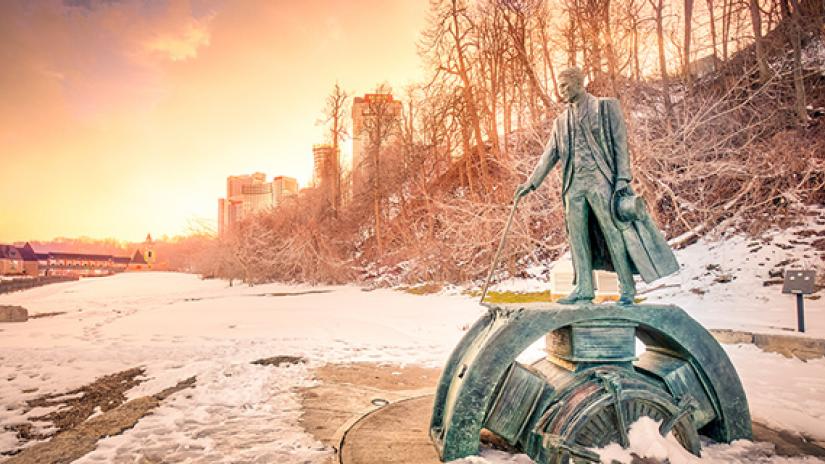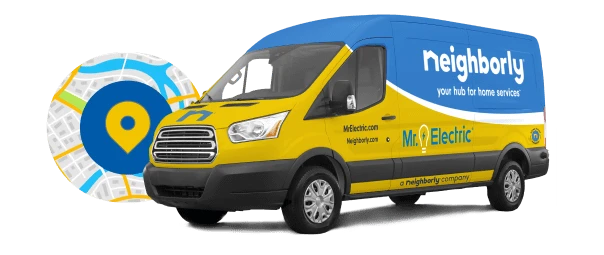
Mr. Electric explores the evolution of electricity
|
Just have a couple of quick questions? Jump to our quick FAQs
- When was electricity invented?
- Who discovered electricity?
- How was electricity first used?
- When did homes start using electricity?
- What was the first electrical invention?
- How has electricity changed over time?
- Who invented the light bulb?
- How does electricity reach our homes today?
- What are some major electrical safety advancements?
- Where can I learn more about home electrical services?
Electricity is an essential part of modern life so vital that most of us cannot imagine a life without it. But – amazingly – it has only been an everyday aspect of our lives for a little over a century.
- Electricity in the Early Days
- The War of the Currents
- The Evolution of Wiring and Electrical Components
- Electricity in the Modern Era
- The Future of Electricity
Back in 1752, when Benjamin Franklin demonstrated that lightning was electrical with his famous kite experiment, people couldn’t even fathom the many conveniences and luxuries that electricity would bring to the 20th and 21st centuries.
Electricity in the Early Days
The first documentation in the history of electricity dates all the way back to 500 B.C. when Thales of Miletus discovered static electricity by rubbing fur on amber. But it wasn’t until two thousand years later, in the 1600s, that English physician and physicist William Gilbert published the first theories about electricity in his book, De Magnete. The next major text about electricity, Experiments and Notes about the Mechanical Origin or Production of Electricity was published in 1675 by English chemist and physicist Robert William Boyle.
The exploration of electricity went up a notch during the next century, though and things started heating up. In the early 1700s – decades before Franklin’s kite – English scientist Francis Hauksbee made a glass ball that glowed when rubbed while experimenting with electrical attraction and repulsion. The glow was bright enough to read by, and this discovery would eventually lead to neon lighting a few centuries later.
Fast forward to September 1882, when a house in Appleton, Wisconsin became the first American home to be powered by hydroelectricity. The station that powered the home used the direct current (DC) system developed by Thomas Edison. Over the next several years, “the direct current versus alternating current (AC)” debate captured attention, as Thomas Edison and George Westinghouse (who championed AC), competed for contracts.
The War of the Currents
Long before electric power in homes became mainstream, the standard form of electricity in the United States was the DC system that Edison developed through General Electric. Nikola Tesla, a student of Edison, believed that AC was a better option because, with the use of transformers, power could be converted to higher or lower voltages much easier and more efficiently. Edison argued – through what some refer to as a “misinformation campaign” – that AC was far more dangerous. This battle peaked in 1893 at the Chicago World’s Fair when General Electric lost its bid to power the fair to George Westinghouse, who was using Tesla’s AC system.
Eventually, because it was cheaper to distribute and could supply power to larger areas, AC became the new standard for electricity in the U.S.
The Evolution of Wiring and Electrical Components
In the earliest days of home electrification, electricity was often carried place to place by bare copper wires with minimal cotton insulation. Sockets, switch handles, and fuse blocks were made of wood. There were no voltage regulators and lights would dim and brighten in response to demand placed on the electrical grid. From about 1890 to 1910, knob and tube wiring was used for electric installation. In this early set-up, hot wires and neutral wires were run separately and were insulated using rubberized cloth, which degraded over time. From the 1920s to the 1940s, flexible armored cable, which offered some protection from wire damage, became commonplace. During the 1940s, electricians began using metal conduit, in which several insulated wires were enclosed in rigid metal tubes.
During these years, the potential for danger was much higher than it is today because wires weren’t grounded. If one of the “hot” wires became damaged or some other mishap caused the electrical current to escape the wiring pathways, fire or severe electrical shock was often the result.
After 1965, grounded wires, which direct stray electrical current back into the ground, created a safer environment for homeowners. (If your house was built before 1965, ground circuit fault interrupters [GFCI] are a great upgrade option. Check with a licensed electrician for more information.) Most modern homes also have circuit breakers that immediately shut off power if they sense an overload, providing additional safeguards.
Electricity in the Modern Era
Well into the 20th century, most Americans continued to illuminate their homes using gas lamps. In 1925, only half of American houses had electrical power. Thanks in great part to FDR’s Rural Electrification Act of 1936, by 1945, 85 percent of American homes were powered by electricity, with virtually all homes having electricity by 1960.
Initially, electricity was used primarily for lighting. But as appliances like vacuum cleaners, refrigerators, and washing machines became more popular starting in the 1950s, demand for electricity grew by leaps and bounds. With today’s myriad appliances and electronic devices, it’s essential to have wiring and components that can handle the heavy load required to power our modern lives.
As we settle into the 21st century, electricity continues to evolve, yet innovations – at least when it comes to our sources of power – have come more slowly. Coal, petroleum, and natural gas have been our primary sources of electrical production since the early 20th century, and alternating current still reigns.
But, there are changes underway.
The Future of Electricity
According to the Center for Climate and Energy Solutions, renewable energy is the fastest-growing source of electricity in the United States, increasing 67 percent from 2000 to 2016. Eco-conscious entrepreneurs are committed to the transition from fossil fuels to renewable electricity – which includes not only wind and solar, but also a renewed focus on hydroelectric power. As technology improves over the next few decades, a transition to renewable power sources as our primary producers of electricity is likely. And, as our appliances – and our homes – get “smarter,” the demand for electricity and new innovations will continue to grow.
In addition, direct current has been making a comeback: LEDs and computers use DC, and engineers have learned that DC may actually be more efficient than AC when transmitting millions of volts over large regions. New DC transformers are able to convert from low to very high voltages just like traditional transformers do with AC. Increased use of electric cars, which operate on DC power, will also push the demand for DC. The International Energy Agency projects that the number of electric cars on the road worldwide will expand from 3 million in 2017 to 125 million by 2030. Finally, using DC power allows for easy integration of wind and solar energy into the electrical grid.
Contact Mr. Electric
The history of electricity is fascinating! Who knows what the future will bring? Regardless of where the latest energy revolutions and inventions take us, one thing is certain: We will always need professional, licensed electricians like the ones at Mr. Electric®. From upgrading electrical panels and wiring to installing complicated electronic devices and appliances, we’ll keep your home’s electricity safe and secure! Make an appointment online with your local Mr. Electric or call us directly.
This article is intended for general informational purposes only and may not be applicable to every situation. You are responsible for determining the proper course of action for your home and property. Mr. Electric is not responsible for any damages that occur as a result of this blog content or your actions. For the most accurate guidance, contact the Mr. Electric location nearest you for a comprehensive, on-site assessment.
FAQs About the History of Electricity
The safety of you, your family, and home are the top priority of every Mr. Electric service professional. Our safety-first commitment to solving your electrical issues includes meticulous attention to detail on every job. Our commitment also includes using our years of experience to answer your questions. Below are answers to some of the most frequently asked questions about the history of electricity.
When was electricity invented?
Electricity wasn’t invented—it has always existed in nature. However, humans began harnessing it in the 18th century, a process expedited by Benjamin Franklin’s famous kite experiment in 1752 and Alessandro Volta’s invention of the battery in 1800. Today, residential electrical services like custom lighting installation continue to evolve.
Who discovered electricity?
Many scientists contributed to our understanding of electricity. The ancient Greeks first observed static electricity, but Benjamin Franklin, Michael Faraday, and Thomas Edison played key roles in developing electrical systems as we know them today. Their discoveries paved the way for modern electrical lighting, wiring, and other innovations in home electrical services.
How was electricity first used?
Early uses of electricity included light bulbs, telegraphs, and early batteries. By the late 19th century, electricity powered homes, businesses, and streetlights. Today, homeowners can benefit from services like surge protection and dedicated electrical circuits for safe, efficient power distribution.
When did homes start using electricity?
Electricity became widely available in homes in the early 20th century. Later, the introduction of dedicated electrical circuits allowed homes to safely power multiple appliances at once. If your home still relies on outdated wiring (though hopefully not from the early 20th century!), consider an electrical wiring upgrade to take advantage of modern features that promote safety and efficiency.
What was the first electrical invention?
The Leyden jar was an early capacitor that stored electrical charge. Discovered in the 1740s by German and Dutch scientists, it was one of the first devices invented to use electricity. Later, light bulbs, generators, and electric panels revolutionized modern life. We don’t offer Leyden jars, but if your home needs an electric panel upgrade, your local Mr. Electric team can help.
How has electricity changed over time?
While electricity as a natural force hasn’t changed over time, the way we harness it sure has! From the earliest simple experiments with static electricity to custom lighting setups and smart devices, the history of electricity reveals the advancements that have transformed the way we live and work. Modern residential electrical services now make homes safer and more energy-efficient.
Who invented the light bulb?
Thomas Edison is credited with perfecting the light bulb, but other inventors like Humphry Davy and Joseph Swan also contributed to its development. Today, Mr. Electric is proud to pick up where they left off! If you need help with anything from light bulb replacement to custom lighting solutions, your local Mr. Electric team has you covered.
How does electricity reach our homes today?
Electricity is generated at power plants, transmitted through high-voltage lines, and distributed to homes. Older power lines are still visible above ground, but many communities now use belowground lines for increased safety and reliability. Electric panel upgrades help ensure homes can handle modern electrical demands. If you’re experiencing electrical issues, a service professional can assess your home’s needs.
What are some major electrical safety advancements?
The introduction of GFCI outlets, surge protection, and exhaust fan installation has made homes safer by reducing electrical hazards. To keep your home up to date with the latest safety features, request a home electrical inspection from a Mr. Electric service professional.
Where can I learn more about home electrical services?
For expert advice on electrical wiring upgrades, outlet repairs, ceiling fan installation, and more, visit our residential electrical services page. Whether you need a quick repair or a major upgrade, your local Mr. Electric team is here to help.
